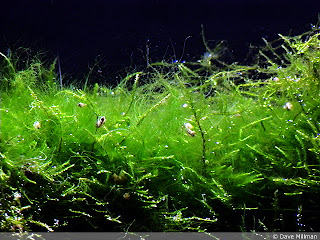Algae for Your Fuel Tank
The available amount of fossil fuels is limited and their combustion in vehicle motors increases atmospheric CO2 levels. The generation of fuels from biomass as an alternative is on the rise. In the journal Angewandte Chemie, Johannes A. Lercher and his team at the Technische Universitaet Muenchen have now introduced a new catalytic process that allows the effective conversion of biopetroleum from microalgae into diesel fuels.
Plant oils from sources such as soybean and rapeseed are promising starting materials for the production of biofuels. Microalgae are an interesting alternative to these conventional oil-containing crops. Microalgae are individual cells or short chains of cells from algae freely moving through water. They occur in nearly any pool of water and can readily be cultivated. "They have a number of advantages over oil-containing agricultural products," explains Lercher. "They grow significantly faster than land-based biomass, have a high triglyceride content, and, unlike the terrestrial cultivation of oilseed plants, their use for fuel production does not compete with food production."
Previously known methods for refining oil from microalgae suffer from various disadvantages. The resulting fuel either has too high an oxygen content and poor flow at low temperatures, or a sulfur-containing catalyst may contaminate the product. However, other catalysts are still not efficient enough. The Munich scientists now propose a new process, for which they have developed a novel catalyst: nickel on a porous support made of zeolite HBeta. They have used this to achieve the conversion of raw, untreated algae oil under mild conditions (260 °C, 40 bar hydrogen pressure). Says Lercher: "The products are diesel-range saturated hydrocarbons that are suitable for use as high-grade fuels for vehicles."
The oil produced by the microalgae is mainly composed of neutral lipids, such as mono-, di-, and triglycerides with unsaturated C18 fatty acids as the primary component (88 %). After an eight-hour reaction, the researchers obtain 78 % liquid alkanes with octadecane (C18) as the primary component. The main gas-phase side products are propane and methane.
Analysis of the reaction mechanism shows that this is a cascade reaction. First the double bonds of the unsaturated fatty acid chains of the triglycerides are saturated by hydrogen. Then, the now saturated fatty acids take up hydrogen and are split from their glycerin component, which reacts to form propane. In the final step, the acid groups in the fatty acids are reduced stepwise to the corresponding alkane.
[Source]
Plant oils from sources such as soybean and rapeseed are promising starting materials for the production of biofuels. Microalgae are an interesting alternative to these conventional oil-containing crops. Microalgae are individual cells or short chains of cells from algae freely moving through water. They occur in nearly any pool of water and can readily be cultivated. "They have a number of advantages over oil-containing agricultural products," explains Lercher. "They grow significantly faster than land-based biomass, have a high triglyceride content, and, unlike the terrestrial cultivation of oilseed plants, their use for fuel production does not compete with food production."
Previously known methods for refining oil from microalgae suffer from various disadvantages. The resulting fuel either has too high an oxygen content and poor flow at low temperatures, or a sulfur-containing catalyst may contaminate the product. However, other catalysts are still not efficient enough. The Munich scientists now propose a new process, for which they have developed a novel catalyst: nickel on a porous support made of zeolite HBeta. They have used this to achieve the conversion of raw, untreated algae oil under mild conditions (260 °C, 40 bar hydrogen pressure). Says Lercher: "The products are diesel-range saturated hydrocarbons that are suitable for use as high-grade fuels for vehicles."
The oil produced by the microalgae is mainly composed of neutral lipids, such as mono-, di-, and triglycerides with unsaturated C18 fatty acids as the primary component (88 %). After an eight-hour reaction, the researchers obtain 78 % liquid alkanes with octadecane (C18) as the primary component. The main gas-phase side products are propane and methane.
Analysis of the reaction mechanism shows that this is a cascade reaction. First the double bonds of the unsaturated fatty acid chains of the triglycerides are saturated by hydrogen. Then, the now saturated fatty acids take up hydrogen and are split from their glycerin component, which reacts to form propane. In the final step, the acid groups in the fatty acids are reduced stepwise to the corresponding alkane.
[Source]


My wife and i felt peaceful that Ervin could conclude his reports from the ideas he discovered out of your weblog. It is now and again perplexing just to possibly be offering guidelines which often others may have been selling. And we also fully grasp we need the writer to thank because of that. The entire illustrations you've made, the straightforward blog navigation, the friendships you assist to promote - it's all impressive, and it's aiding our son and us feel that this matter is thrilling, and that's tremendously indispensable. Thank you for all!
ReplyDeleteStanley 77-189 FatMax PB2 Self-Leveling Laser Plumb Bob